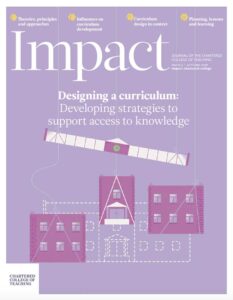Building curriculum coherence

When the curriculum lacks coherence, it is both harder to teach and harder for students to locate and place their new knowledge.
The notion of curriculum coherence can be considered at three levels: the national level, the school level and the classroom level. Although all three have a profound impact on pupils’ learning, it is at the classroom level that its impact is most directly felt.
In terms of the national level, curriculum coherence was identified by Professor Tim Oates in his report ‘Could do better’ (Oates, 2011) as one of the characteristics of high-performing countries. He argues: ‘The weight of evidence from transnational comparison is that a certain degree of curriculum control is necessary (that this need not be associated with “top down” control or control exercised exclusively by the State) and that this control should be directed towards attaining “curriculum coherence”.’ He then goes on to say (Oates, 2011, p. 126):
The term ‘coherence’ does not carry the meaning typically associated with a ‘broad and balanced curriculum’ but is a precise technical term: a national curriculum should have content arranged in an order which is securely based in evidence associated with age-related progression, and all elements of the system (content, assessment, pedagogy, teacher training, teaching materials, incentives and drivers etc.) should all line up and act in a concerted way to deliver public goods.
This is not just a trivial, common-language use of the term ‘coherence’. A system is regarded as ‘coherent’ when the National Curriculum content, textbooks, teaching content, pedagogy, assessment, and drivers and incentives are all aligned and reinforce one another. ‘Curricular materials in high-performing nations focus on fewer topics, but also communicate the expectation that those topics will be taught in a deeper, more profound way’ (Schmidt and Prawat, 2006).
The second location for coherence is at school leadership level. The curriculum planning is more than the timetable. It is about leaders having thoughtful conversations with colleagues about the curriculum map for the pupils in their school. It means paying careful attention to how the material to be studied is organised. It means rethinking topic work and the muddle that was possible, although not inevitable, from ‘topics’ with titles such as ‘water’ or ‘colour’. Unless such vague topics are underpinned by a clear rationale and conceptual rigour, then they devolve into ridiculous, tenuous links, such as a history teacher in desperation linking the theme of colour to the Black Death, which Clare Sealy (Sealy, 2017) describes, or a theme on water, where in religious education this gets translated into Jesus walking on water. And yes, he probably would have wept. While these examples are amusing, they are doing a real disservice to pupils’ cognitive development.
There are three things to take account of here: the first is that knowledge facts need to be underpinned by concepts and that these need to be taught explicitly; the second is that knowledge should be taught primarily through texts, art and music; and the third is that knowledge needs to reside in and be protected within the discipline, otherwise we end up with a ‘cardboard’ curriculum.
To take concepts first: these are ‘holding baskets’ for facts. They help to make sense of multiple pieces of information and this makes them efficient. Concepts are largely, but not exclusively, expressions of important ideas within an academic discipline. Our pupils are entitled to know them and to use them. Concepts enable connections to be made across a disparate range of facts; they reside in the long-term memory and can be called on to make sense of new information. Concepts provide the intellectual architecture onto which new knowledge and insights can be pinned.
My second argument is that our primary sources of knowledge in the classroom should be texts, artefacts, music and art. Knowledge needs to be located within the realm of the subject, not gobbetised and sanitised via a second-rate worksheet. My experience is that pupils rise to the occasion, that they can cope with demanding stuff and are crying out for authentic knowledge.
The final strand is that it is important to maintain a clear distinction between the interdisciplinary and the cross-curricular. Interdisciplinary keeps the integrity of subject-specific knowledge intact. Thus, for example, a unit on Christian pilgrimage might draw on the Canterbury Tales in English and Thomas à Becket in history, and a visit to Canterbury Cathedral in order to enlarge on pilgrimage, not be subsumed by the other subjects.
If we don’t hold steady on the knowledge and the integrity of the discipline, then we end up in a muddle. And so do our pupils. This is not to say that links across a curriculum are not possible and cannot add additional richness and complexity to a subject – rather, that we need to ask ourselves the question: what is the main idea that we want pupils to think about?
Thinking hard about coherence matters, because if we don’t then what is offered to children is fragmented and piecemeal. This means that their fragments of knowledge float around without being placed in a coherent structure, and so a rationale is needed. This is clearly articulated in the National Curriculum – at the start of each subject area to be taught is a clear statement providing a holistic overview. This needs to be held in mind when constructing long- and medium-term plans and also in the daily delivering of lessons. It takes just a few moments to remind ourselves and our pupils how what we are learning today fits into this bigger picture. This is both more satisfying and also more effective. It is more satisfying because everyone can see how the learning today relates to the curriculum as a whole and it is more effective because the detail of today is more likely to stick when put into the context of the overall scheme, rather like looking at the picture on the box before trying to fit the pieces of the jigsaw together.
There is a second strand to curriculum coherence at school level and it is this: careful attention needs to be paid to the underlying knowledge that pupils need in order to access the subject in later years. A good example of this is an English department at Dover Grammar School for Girls, where Claire Hill is head of English and media studies: she and her colleagues have identified the biblical and classical allusions needed in order to study Macbeth, for example, and they have included these in a unit for Key Stage 3. Working in this careful, structured way is light years away from scrappy, ad-hoc lessons that do not create the opportunities and expectations for pupils to be ‘au fait’ with essential background knowledge.
We are a pattern-seeking species. We look to make sense and order from the world around us. The plethora of information and stimuli becomes overwhelming if each is encountered without a context into which to place it. From our earliest days, man has sorted information in order to categorise the world. Noticing that some things support life and others are likely to endanger it is an essential aspect of human survival.
Our fascination with the world and the skies is linked to our seeking pattern and order. So it is hard-wired into us to want to see how things connect. And this idea should be fundamental to thinking about a curriculum and its coherence. Coherence comes from the Latin ‘to stick together’, and when we think about the curriculum coherently, it becomes much simpler both to teach and for pupils to understand. And the coherence comes from paying attention to the big ideas that underpin each curriculum area. These have not been written as a pretty piece of prose by way of introduction, but are the essential ‘memes’ through which the detail is expressed. The temptation is to go straight to the detail of what needs to be taught. And this is understandable when we are under time pressure. But in the long term, we waste time because we have not invested in two things: identifying the key ideas and concepts, and sharing these with our pupils. This means that we are denying them the chance to get the material to stick together.
When the curriculum lacks coherence, it is both harder to teach and harder for children to locate and place their new knowledge. Each of the subject areas of the National Curriculum has two sections at the start before going into detail. Firstly, the purpose sets out the reason why this subject needs to be taught and the impact of teaching it on pupils. The purpose is followed by the aims and sets out the entitlement for all pupils. Combined, these provide a platform both for thinking about and for making sense of the curriculum detail and for ensuring that every child has access to it.










